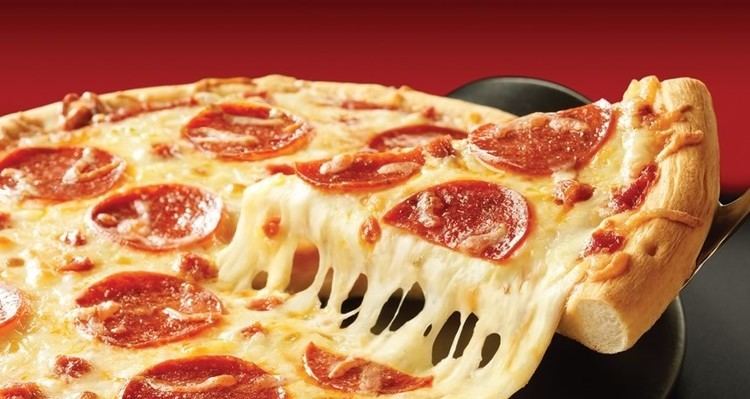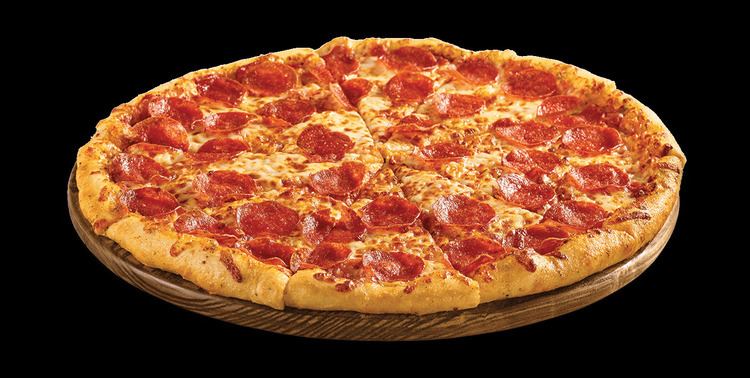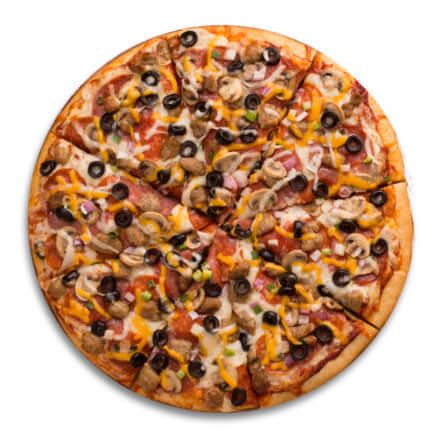Serving temperature Hot or warm | Course Lunch or dinner | |
 | ||
Similar Hamburger, Cheese, Dough, Bread, Sushi | ||
Deep dish pan pizza veggie lover s pizza video recipe by bhavna
Pizza is a yeasted flatbread generally topped with tomato sauce and cheese and baked in an oven. It is commonly topped with a selection of meats, vegetables and condiments. The term was first recorded in the 10th century, in a Latin manuscript from Gaeta in Central Italy. The modern pizza was invented in Naples, Italy, and the dish and its variants have since become popular and common in many areas of the world.
Contents
- Deep dish pan pizza veggie lover s pizza video recipe by bhavna
- Chicken pan pizza no oven stove top pizza snack iftar dish
- Etymology
- History
- Preparation
- Cooking
- Crust
- Cheese
- Italy
- United States
- Records
- Health issues
- National Pizza Month
- Similar dishes
- References

In 2009, upon Italy's request, Neapolitan pizza was safeguarded in the European Union as a Traditional Speciality Guaranteed dish. The Associazione Verace Pizza Napoletana (the True Neapolitan Pizza Association) is a non-profit organization founded in 1984 with headquarters in Naples. It promotes and protects the "true Neapolitan pizza".

Pizza is sold fresh or frozen, either whole or in portions, and is a common fast food item in Europe and North America. Various types of ovens are used to cook them and many varieties exist. Several similar dishes are prepared from ingredients commonly used in pizza preparation, such as calzone and stromboli.

Chicken pan pizza no oven stove top pizza snack iftar dish
Etymology

The word "pizza" (Italian: [ˈpittsa]) first appeared in a Latin text from the southern Italy town of Gaeta, then still part of the Byzantine Empire, in 997 AD; the text states that a tenant of certain property is to give the bishop of Gaeta duodecim pizze ("twelve pizzas") every Christmas Day, and another twelve every Easter Sunday".
Suggested etymologies include:

History
Foods similar to pizza have been made since the neolithic age. Records of people adding other ingredients to bread to make it more flavorful can be found throughout ancient history. The ancient Greeks covered their bread with oils, herbs and cheese, and in the 6th century BC, the soldiers in Persian King Darius I's armies baked flatbreads with cheese and dates on top of their battle shields.
Modern pizza evolved from similar flatbread dishes in Naples, Italy in the 18th or early 19th century. Prior to that time, flatbread was often topped with ingredients such as garlic, salt, lard, cheese, and basil. It is uncertain when tomatoes were first added and there are many conflicting claims. Until about 1830, pizza was sold from open-air stands and out of pizza bakeries, and pizzerias keep this old tradition alive today.
A popular contemporary legend holds that the archetypal pizza, pizza Margherita, was invented in 1889, when the Royal Palace of Capodimonte commissioned the Neapolitan pizzaiolo (pizza maker) Raffaele Esposito to create a pizza in honor of the visiting Queen Margherita. Of the three different pizzas he created, the Queen strongly preferred a pizza swathed in the colors of the Italian flag: red (tomato), green (basil), and white (mozzarella). Supposedly, this kind of pizza was then named after the Queen, although recent research casts doubt on this legend.
Pizza was brought to the United States with Italian immigrants in the late nineteenth century, and first appeared in areas where Italian immigrants concentrated. The country's first pizzeria, Lombardi's, opened in 1905. Following World War II, veterans returning from the Italian Campaign after being introduced to Italy's native cuisine proved a ready market for pizza in particular. Since then pizza consumption has exploded in the U.S. Pizza chains such as Domino's, Pizza Hut, and Papa John's, pizzas from take and bake pizzerias, and chilled or frozen pizzas from supermarkets make pizza readily available nationwide. It is so ubiquitous, thirteen percent of the U.S. population consumes pizza on any given day.
Preparation
Pizza is prepared fresh, frozen, and as portion-size slices or pieces. Methods have been developed to overcome challenges such as preventing the sauce from combining with the dough and producing a crust that can be frozen and reheated without becoming rigid. There are frozen pizzas with raw ingredients and self-rising crusts.
Another form of uncooked pizza is available from take and bake pizzerias. This pizza is assembled in the store, then sold to customers to bake in their own ovens. Some grocery stores sell fresh dough along with sauce and basic ingredients, to complete at home before baking in an oven.
Cooking
In restaurants, pizza can be baked in an oven with stone bricks above the heat source, an electric deck oven, a conveyor belt oven or, in the case of more expensive restaurants, a wood- or coal-fired brick oven. On deck ovens, pizza can be slid into the oven on a long paddle, called a peel, and baked directly on the hot bricks or baked on a screen (a round metal grate, typically aluminum). Prior to use, a peel may be sprinkled with cornmeal to allow pizza to easily slide onto and off of it. When made at home, it can be baked on a pizza stone in a regular oven to reproduce the effect of a brick oven. Another option is grilled pizza, in which the crust is baked directly on a barbecue grill. Greek pizza, like Chicago-style pizza, is baked in a pan rather than directly on the bricks of the pizza oven.
When it comes to preparation, the dough and ingredients can be combined on any kind of table. With mass production of pizzas the process can be completely automated. Most restaurants still use standard and purpose built pizza preparation tables. Pizzerias nowadays can even opt for hi tech pizza preparation tables that combine mass production elements with traditional techniques.
Crust
The bottom of the pizza, called the "crust", may vary widely according to style—thin as in a typical hand-tossed Neapolitan pizza, or thick as in a deep-dish Chicago-style. It is traditionally plain, but may also be seasoned with garlic or herbs, or stuffed with cheese. The outer edge of the pizza is sometimes referred to as the cornicione. Often pizza dough contains sugar, both to help its yeast rise and enhance browning of the crust.
Cheese
Mozzarella is commonly used on pizza, with the highest quality buffalo mozzarella produced in the surroundings of Naples. Today, other cheeses have been used as pizza ingredients, including provolone, pecorino romano, ricotta, and scamorza.
Less expensive processed cheeses or cheese analogues have been developed for mass-market pizzas to produce desirable qualities like browning, melting, stretchiness, consistent fat and moisture content, and stable shelf life. This quest to create the ideal and economical pizza cheese has involved many studies and experiments analyzing the impact of vegetable oil, manufacturing and culture processes, denatured whey proteins and other changes in manufacture. In 1997 it was estimated that annual production of pizza cheese was 1 million tonnes (1,100,000 short tons) in the U.S. and 100,000 tonnes (110,000 short tons) in Europe.
Italy
Authentic Neapolitan pizza (pizza napoletana) is typically made with San Marzano tomatoes, grown on the volcanic plains south of Mount Vesuvius, and mozzarella di bufala Campana, made with milk from water buffalo raised in the marshlands of Campania and Lazio. This mozzarella is protected with its own European protected designation of origin. Other traditional pizzas include pizza alla marinara, which is topped with marinara sauce and is allegedly the most ancient tomato-topped pizza, pizza capricciosa, which is prepared with mozzarella cheese, baked ham, mushroom, artichoke and tomato, and pizza pugliese, prepared with tomato, mozzarella and onions.
A popular variant of pizza in Italy is Sicilian pizza (locally called sfincione or sfinciuni), a thick-crust or deep-dish pizza originating during the 17th century in Sicily: it is essentially a focaccia that is typically topped with tomato sauce and other ingredients. Until the 1860s, sfincione was the type of pizza usually consumed in Sicily, especially in the Western portion of the island. Other variations of pizzas are also found in other regions of Italy, for example pizza al padellino or pizza al tegamino, a small-sized, thick-crust and deep-dish pizza typically served in Turin, Piedmont.
United States
Common toppings for pizza in the United States include ground beef, mushrooms, onions, pepperoni, pineapple, garlic, chicken and sausage.
Distinct regional types developed in the twentieth century, including California, Chicago, Greek, and New York styles. The first pizzeria in the U.S. was opened in New York's Little Italy in 1905 and since then regions throughout the U.S. offer variations, including deep-dish, stuffed, pockets, turnovers, rolled and pizza-on-a-stick, each with seemingly limitless combinations of sauce and toppings.
Another variation is grilled pizza, created by taking a fairly thin, round (more typically, irregularly shaped) sheet of yeasted pizza dough, placing it directly over the fire of a grill and then turning it over once the bottom has baked and placing a thin layer of toppings on the baked side. Toppings may be sliced thin to ensure that they heat through, and chunkier toppings such as sausage or peppers may be precooked before being placed on the pizza. Garlic, herbs, or other ingredients are sometimes added to the pizza or the crust to maximize the flavor of the dish.
Grilled pizza was offered in the United States at the Al Forno restaurant in Providence, Rhode Island by owners Johanne Killeen and George Germon in 1980. Although it was inspired by a misunderstanding that confused a wood-fired brick oven with a grill, grilled pizza did exist prior to 1980, both in Italy, and in Argentina where it is known as pizza a la parrilla. It has become a popular cookout dish, and there are even some pizza restaurants that specialize in the style. The traditional style of grilled pizza employed at Al Forno restaurant uses a dough coated with olive oil, strained tomato sauce, thin slices of fresh mozzarella, and a garnish made from shaved scallions, and is served uncut. The final product can be likened to flatbread with pizza toppings. Another Providence establishment, Bob & Timmy's Grilled Pizza, was featured in a Providence-themed episode of the Travel Channel's Man v. Food Nation in 2011.
Records
The world's largest pizza was prepared in Rome in December 2012, and measured 1,261 square metres (13,570 sq ft). The pizza was named "Ottavia" in homage to the first Roman emperor Octavian Augustus, and was made with a gluten-free base. The world's longest pizza was made in Naples in 2016. It was baked using a series of wheeled ovens which moved along its length, and measured 1.85 kilometres (1.15 mi).
The world's most expensive pizza listed by Guinness World Records is a commercially available thin-crust pizza at Maze restaurant in London, United Kingdom, which costs GB£100. The pizza is wood fire-baked, and is topped with onion puree, white truffle paste, fontina cheese, baby mozzarella, pancetta, cep mushrooms, freshly picked wild mizuna lettuce, and fresh shavings of a rare Italian white truffle.
There are several instances of more expensive pizzas, such as the GB£4,200 "Pizza Royale 007" at Haggis restaurant in Glasgow, Scotland, which has caviar, lobster and is topped with 24-carat gold dust, and the US$1,000 caviar pizza made by Nino's Bellissima pizzeria in New York City, New York. However, these are not officially recognized by Guinness World Records. Additionally, a pizza was made by the restaurateur Domenico Crolla that included toppings such as sunblush-tomato sauce, Scottish smoked salmon, medallions of venison, edible gold, lobster marinated in cognac, and champagne-soaked caviar. The pizza was auctioned for charity in 2007, raising GB£2,150.
Health issues
Some mass-produced pizzas by fast food chains have been criticized as having an unhealthy balance of ingredients. Pizza can be high in salt, fat and food energy. The USDA reports an average sodium content of 5,101 mg per 14 in (36 cm) pizza in fast food chains. There are concerns about negative health effects. Food chains have come under criticism at various times for the high salt content of some of their meals.
Frequent pizza eaters in Italy have been found to have a relatively low incidence of cardiovascular disease and digestive tract cancers relative to infrequent pizza eaters, although the nature of the correlation between pizza and such perceived benefits is unclear. Pizza consumption in Italy might only indicate adherence to traditional Mediterranean dietary patterns, which have been shown to have various health benefits.
Some attribute the apparent health benefits of pizza to the lycopene content in pizza sauce, which research indicates likely plays a role in protecting against cardiovascular disease and various cancers.
National Pizza Month
National Pizza Month is an annual observance that occurs for the month of October in the United States and some areas of Canada. This observance began in October 1984, and was created by Gerry Durnell, the publisher of Pizza Today magazine. During this time, some people observe National Pizza Month by consuming various types of pizzas or pizza slices, or going to various pizzerias.
